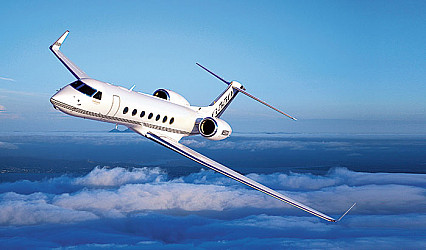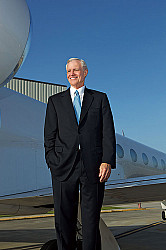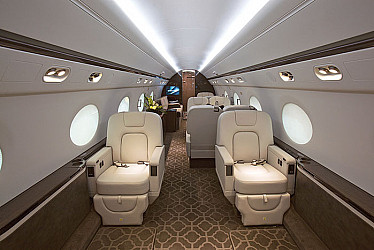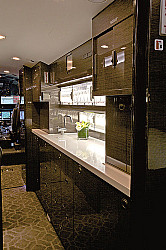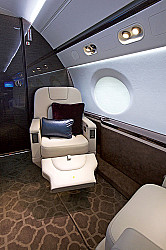The Sky’s The Limit!
It’s a jet-setting age, literally. As frequent flying from one global destination to another becomes a norm, Roger Sperry, Regional Senior Vice-President, International Sales South America /Far-East Gulfstream Aerospace Corporation answers questions on how luxury is redefined and seamlessly intertwined with business, up in the air….
Would you say that the skies have opened up, literally, for high net-worth people?
We’re in a new era of mobility. High net-worth and corporate leadership often goes hand-in-hand. It’s becoming easier to get around, because aircraft, such as our G450 and G550, have such long range, and easier access in important markets. For the Indian entrepreneur, it’s now quite routine to hop aboard a private jet and fly to Dubai for a day. On our larger planes, Mumbai to London is a piece of cake.
What would induce captains of industry to invest in private jets/planes?
Business people see the time savings, the convenience and the work that can get done en route. They also experience an improvement in the quality of life. When it’s not such a drain to just get somewhere for business, you are more inclined to take the appointment in Nairobi or New York. You don’t burn out from the airline travel. So, people in their prime stay engaged in their businesses longer, helping companies retain valuable experience.
Has the market opened up for luxury private jets in India?
There is no question that we are selling more airplanes in India. Our market in India, still relatively small today, has quadrupled in 10 years and continues to grow. Certainly, we face some capacity constraints and other infrastructure challenges, but these are the growing pains of an emerging economy and a need for more private jets. Over time these challenges will sort themselves out. Mumbai has a beautiful executive terminal now, by the way. That’s a nice sign of a maturing market.
What is your client profile?
It’s a diverse group across the globe and India is no exception. Of course, there are the glamour passengers, but what we see most day in and day out are business people who are using these jets not to display wealth, but to create it. Think about it: one trip – one-face-to-face meeting and contract signing – could mean a billion-dollar deal or acquisition. The price of the flight is almost insignificant in comparison to the value of some of these transactions. For stars, they are their most valuable commodity. The more places they show up for work, the more money they make.
The jet would almost function like an office away from your office. What is its USP?
You have it precisely right. It’s an office in the sky and often a home in the sky, too. When your flight times are 10 to 14 hours, you are going through your whole daily cycle – working, sleeping, having breakfast and dinner. We can berth the seats and make comfortable beds, serve fantastic meals from the galley, and keep executives in touch through satellite communications. I’m writing this and sending it to you now from over the Pacific. That’s the way we use our demo aircraft when we travel. As far as a USP, it’s hard to point to just one thing. Gulfstream aircraft are often referred to by our customers as the Rolls Royce of the sky. These aircraft have the best performance, the most comfort, the highest reliability and the best worldwide product support network. It’s hard to pick just one special attribute.
In what way do you offer individual customisation of each plane?
The experience of flying in a business jet is not quite out of this world, but up above 40,000 feet it is quiet and smooth and serene. Our larger airplanes have 12 standard floor plans and then hundreds of customisation choices. So our owners really feel as if they are furnishing their private homes according to their individual tastes. The one thing everybody gets is the trademark Gulfstream large oval window. And there is just nothing like it for creating a light, airy cabin and seeing the world in a way it cannot be viewed from any other plane.
The number of Gulfstream jets multiplied despite the economic downturn that slowed the world down. How did you remain optimistic during the tough years?
While the U.S. and European markets slowed, international markets picked up. Demand for our large cabin aircraft stayed high and demand for our mid-cabin aircraft is returning. We never stopped investing in expanding product support or developing new aircraft such as the G250 and G650, both of which will be certified this year and enter service with customers in 2012. When you focus your energies on producing the premium product and show customers the dedication to supporting it, it goes a long way to blunting the effects of a down economy.
In what sense would you say Gulfstream has pioneered this trend in the skies?
Gulfstream has always focused on technological leadership, introducing the first truly long-range, large-cabin jet, the G-II in 1966, and inventing new safety technologies like the Enhanced Vision System, which lets pilots have a day-like view in pitch blackness or reduced visibility. We are always working to invent new ways of flying better, and the G650, our 12,800 km, .925 Mach jet is probably the best example of that. It’s the fastest civil airplane in the world – near the speed of sound; it’s the largest purpose-built business jet; and, remarkably, it’s 10 per cent more fuel efficient than our current largest aircraft. You achieve those things with a heavy investment in R&D.
Service and safety – those are the important words at Gulfstream.
No question about it. First you design the airplanes for durability and reliability; you design safety systems like the PlaneView cockpit, which gives pilots the tools to fly safely; and you back it all up with a service organisation of 3,300 people and a worldwide spares network worth $1.2 billion.
Alongside, is luxury….
Our cabin pressurisation rate is higher, which means you get more oxygen into your bloodstream when you fly and that makes a big difference on say a 10-hour flight in terms of the way you feel at the end of it. We have 100 per cent fresh air flow through the cabin. A lot of airplanes re-circulate air and that’s not as healthy. Our cabins are quiet. Noise and vibration take a toll. You can talk to fellow passengers as if you were in the office.
Would you say these are more investment options, status symbols or convenience buys?
They are business tools. They help facilitate business. Gulfstream aircraft tend to retain their value. It is somewhat dependent on the overall economy, but it’s not unknown to sell an aircraft for more than you bought it for. People buy aircraft for all sorts of reasons, but it’s primarily to get somewhere fast and hassle free. That’s where we shine.
Related posts from Verve:
Verve Trending
Sorry. No data so far.
us on Facebook to stay updated with the latest trends

